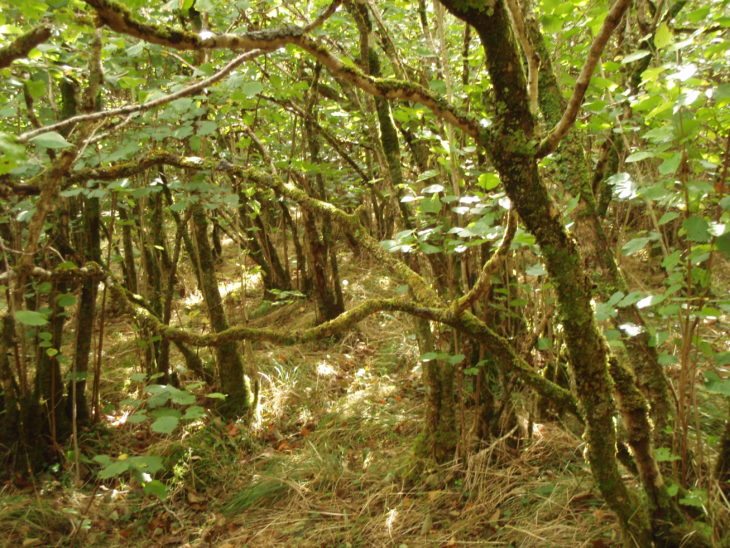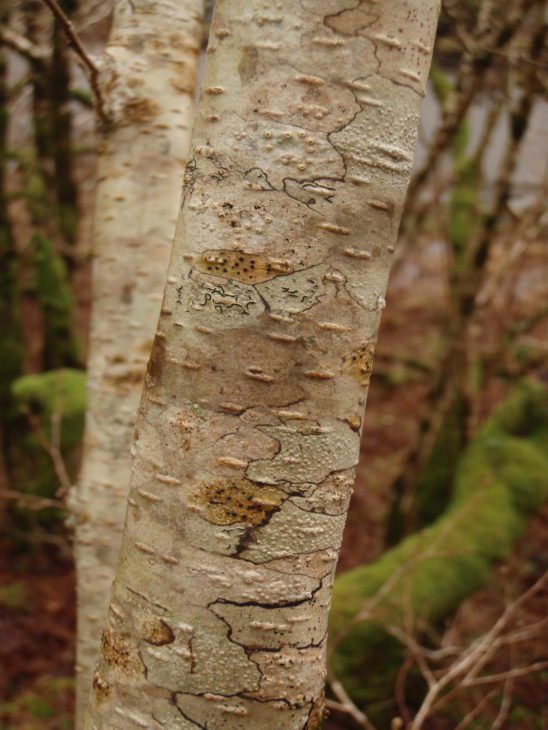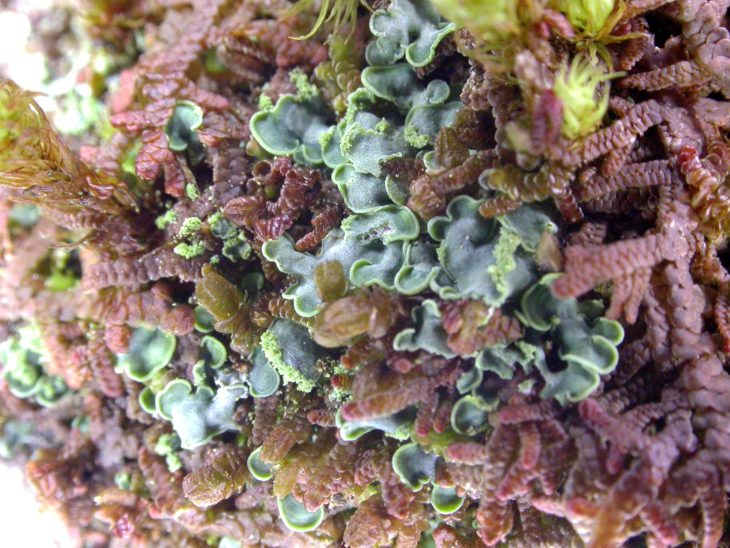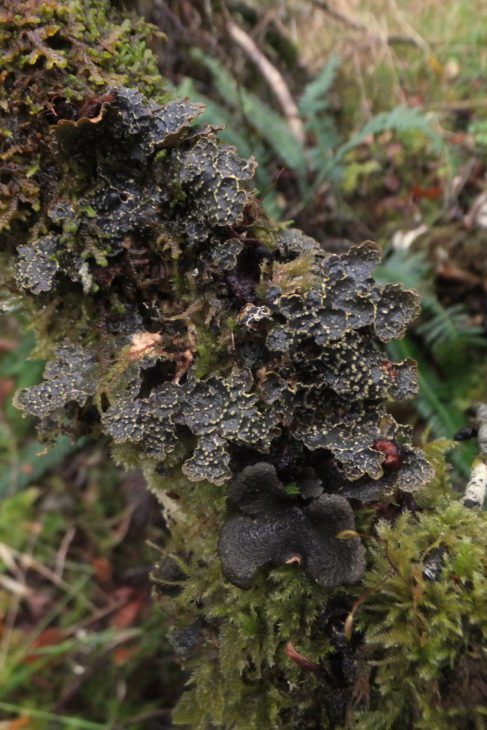The secret life of lichens
Brian and Sandy Coppins have been studying lichens in Scotland and further afield for decades. In this blog they explain the basics of lichens, and why our Ballachuan Hazelwood Wildlife Reserve is home to hundreds of different types.
Where can you go to see the Norwegian Specklebelly? Octopus suckers? Stinky Stictas, Green satin? Not to mention Elf-ears, Jelly-skins, Brown shingles, Tree Lungwort and Lob scrob?
Try the Scottish Wildlife Trust’s Ballachuan Hazelwood reserve. If you look you will see all of these, and more. In fact Ballachuan Hazelwood is home to over 372 different lichens.

What is a lichen?
To a lot of people, lichens are ‘difficult’. For a starter, just how do you say “Lichen”? Is it “hitchin’ for lichen” or “bikin’ for lichen”? Usually it is the latter pronunciation, but there is no hard and fast rule. And then – what is a lichen?
A lichen is a clever combination of two organisms, a fungus and one (or more) alga. The fungus forms the body of the lichen (the bit you see) and the alga (hidden away inside the lichen body), manufactures the food for both of them. The alga makes the food by a process known as photosynthesis (a word of Greek origin, with photo = light; and synthesis = putting together). So how does it work? The alga uses the energy from sunlight to combine water and carbon dioxide in the air into carbohydrates (food).
It sounds like the fungus gets a good deal, but of course, the fungus needs to protect its food-provider alga from desiccation in hot dry weather or drowning in excessively wet conditions, from harmful ultraviolet rays, and from extreme cold and frost. Lichens have evolved to be successful through this mutual reliance.
If you are a lichen sitting on a tree, or on rocks and boulders or on the ground in montane areas, just think of the extreme conditions that you will encounter, from harsh summer drought, torrential rain and stormy winds, to freezing frost and snow in the winter. Fortunately, frost and snow are not often experienced at Ballachuan Hazelwood, which is one reason why the hazels and rocks are dripping with lichens and mosses.

Why is Ballachuan so important for lichens?
So, a lichen is a neat little self-sufficient package – given enough light, water and clean air, they will grow happily. But, at Ballachuan, there are some very special lichens which don’t just grow anywhere – and there is another very important factor which is essential for these special lichens to thrive – they need the place where they grow to have a long history of stability.
They need old woodlands, they need a habitat of comfortable continuity where disturbance is low, and things tick over quietly. Ballachuan Hazelwood satisfies these criteria on two counts:
The woodland covers 23 hectares and is almost entirely all hazel. It’s regarded as one of the most important Atlantic Hazelwood sites in Scotland and is one of Scotland’s most ancient woodlands.
Together with birch, hazel was one of the earliest woody species to establish along the western edge of Scotland, as far back as 10,000 years ago. Pollen evidence points to vast areas of western Scotland being dominated by hazel for hundreds of years and today the remaining hazel woodlands form a unique habitat of great antiquity.
In Western Scotland, hazel was not coppiced (periodically cut down to ground level) in the English tradition. Hazel stools are naturally multi-stemmed, they grow that way without coppicing. Ancient hazel doesn’t necessarily have thick, craggy and woody trunks, although there are examples like this. Hazel will put up new shoots each spring to fill in gaps in the canopy where older stems have died or been damaged by storms, and so the hazel stool quietly reproduces year on year.

People in Western Scotland certainly made use of hazel in many ways, but because it is widespread, they did not have to go to all the labour of coppicing entire stools, then having to protect the regrowth from grazing animals. They were able to walk in among the hazel, and selectively cut just the stems they wanted. This ensured that the hazel stand provided them with what they needed, and was also able to be used as sheltered grazing for domestic animals.
And this combination of the gentle, wet Atlantic climate, of ancient woodland and low intensity management, suited the wonderful lichens associated with Atlantic hazel, so that they survived and thrived, and are now rightly regarded as of international importance. Just imagine, as you step into Ballachuan, into the secret greenness, the dwarf wood, you could be walking in one of the truly oldest woods in Scotland. And the lichens tell the story.

There are the dramatic leafy-lobed lichens. And then are the more subtle ones, where the smooth bark of slender hazel stems are mottled with pale mosaics of silvery-white, cream, russet, grey and green. These are the small lichens, the ‘crustose’ species, and include some of the real specialities of the Atlantic Hazelwoods with some not being found anywhere else in the world.
In many ways, it is not important to know “what is a lichen?”. You can simply seek them out, look and be fascinated, and just enjoy them for their wonder and beauty.
by Brian and Sandy Coppins
Find out more about lichens
Sandy and Brian Coppins have been studying, recording and surveying lichens in Scotland, elsewhere in the British Isles, and abroad for the last 40 years. They delight in looking at lichens, and sharing them with other folk.
Their illustrated book Atlantic Hazel – Scotland’s Special Woodlands is available through NHBS priced £10.99. They also recommend the Lichens of Atlanic Woodlands Guide, available to download from Plantlife.
Help protect Scotland’s wildlife
Our work to save Scotland’s wildlife is made possible thanks to the generosity of our members and supporters.
Join today from just £3 a month to help protect the species you love.
Preface
Brian and Sandy Coppins have been studying lichens in Scotland and further afield for decades. In this blog they explain the basics of lichens, and why our Ballachuan Hazelwood Wildlife …
